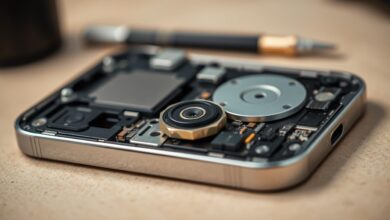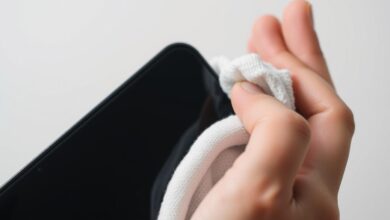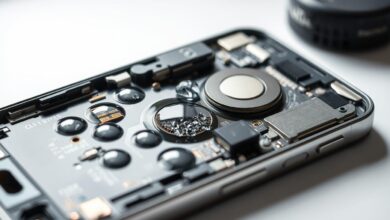how to clean speaker on iphone
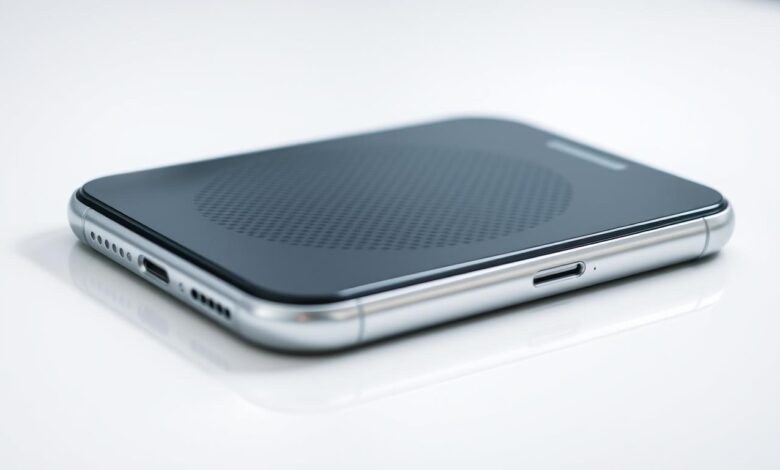
If you use an iPhone, you might have noticed when the sound gets muffled or distorted. This often happens because dust, dirt, and other particles get stuck in the speaker grills. In this guide, I’ll show you how to clean your iPhone’s speaker and get back to clear sound.
Cleaning your iPhone’s speaker is key to keeping the sound quality high. By following these steps, you can get rid of dirt and debris. This will make sure your device’s audio is clear and free from distortion.
Key Takeaways
- Understand the importance of cleaning your iPhone’s speaker for optimal sound quality.
- Learn the simple steps to clean your iPhone’s speaker effectively.
- Discover the tools needed to clean your iPhone’s speaker.
- Improve your device’s audio quality by removing dirt and debris.
- Follow a comprehensive guide to cleaning your iPhone’s speaker like a pro.
Understanding iPhone Speakers and Why They Need Cleaning
Knowing how your iPhone’s speakers work is important for keeping them clean and working well. Your iPhone has several speakers, each with its own job. Understanding this can help you keep them in top shape.
Types of Speakers on Your iPhone
Your iPhone has many speakers, like the earpiece, bottom loudspeaker, and microphones. Each one is crucial for a good user experience.
Earpiece Speaker (Receiver)
The earpiece speaker is at the top front of your iPhone. It helps you hear during calls, so you don’t need a hands-free device.
Bottom Loudspeaker
The bottom loudspeaker is at the bottom of your iPhone. It’s for music, videos, and more. It makes sounds louder for a better audio experience.
Microphones and Their Locations
Your iPhone also has many microphones. They pick up your voice for calls, recordings, and more. These microphones are placed carefully for clear sound.
Common Causes of Speaker Blockage
Several things can block your iPhone speakers, making them less effective. Knowing what causes these blockages can help you prevent them.
Dust and Lint Accumulation
Dust and lint often clog iPhone speakers. These particles can get into the speaker grilles and lower sound quality.
Pocket Debris and Skin Particles
Debris from your pocket, like dust and dirt, can also block speakers. This happens when you carry your iPhone in a pocket or bag without protection.
Food and Liquid Residue
Food and liquid spills can block speakers too. Crumbs or spills can get into the speaker grilles and mess with sound quality.
Signs Your iPhone Speaker Needs Cleaning
Knowing when your iPhone speaker needs cleaning is key to great sound. A dirty speaker can mess up your music, videos, and calls.
Audio Quality Issues
A drop in sound quality is a big clue. It can show up in different ways:
Muffled Sound Output
If your iPhone sounds muffled or covered, it’s probably dirty. Debris is blocking the speaker grilles.
Crackling or Distorted Audio
Crackling or distorted audio means your speaker is clogged. Dirt or dust is messing with the sound’s clarity.
Volume Problems
Volume issues can also mean your speaker needs a clean. This includes:
Decreased Maximum Volume
If your iPhone’s max volume is lower, blockages might be the reason.
Uneven Sound Distribution
Uneven sound distribution means sound is off-balance. It could mean one speaker is clogged.
Call Quality Degradation
Dirty speakers can also hurt call quality. Look out for:
Difficulty Hearing Callers
Struggling to hear the other person on calls? It might be a blocked earpiece speaker.
Others Having Trouble Hearing You
If others can’t hear you well, it’s likely the bottom speaker is clogged. This speaker is used for the microphone during calls.
Essential Tools and Materials for Cleaning iPhone Speakers
Having the right tools is key for safely cleaning your iPhone’s speaker. The right tools help remove debris and dust without harming the delicate parts.
Safe Cleaning Tools
Several tools are recommended for cleaning iPhone speakers. These include:
- Soft-Bristled Brushes: Gentle on the speaker grills and effective at removing loose debris.
- Compressed Air Cans: Useful for blowing out dust and dirt from the speaker grills.
- Adhesive Putty or Cleaning Slime: Can pick up small particles and dust from the speaker areas.
- Microfiber Cloths: Soft and gentle, these cloths can wipe down the speaker areas without scratching.
Materials to Avoid
It’s also important to know what materials to avoid when cleaning your iPhone speaker. Some materials can cause damage or push debris further into the speaker.
- Liquid Cleaners and Solvents: Can damage the speaker components or harm the phone’s internal electronics.
- Sharp Objects and Metal Tools: May scratch or puncture the speaker grill or internal parts.
- Cotton Swabs and Fibers: Can leave behind fibers or push debris further into the speaker.
By using the right tools and avoiding harmful materials, you can effectively clean your iPhone’s speaker. This helps maintain its audio quality.
Precautions Before You Start Cleaning
Before you start cleaning your iPhone speaker, there are a few things to do first. Cleaning your iPhone’s speaker can be delicate. Taking the right steps will protect your device from damage.
Protecting Your iPhone from Damage
Before you start, protect your iPhone from damage. This involves a few simple steps.
Powering Off Your Device
First, power off your iPhone completely. This stops any accidental activations or electrical surges that could harm your device during cleaning.
Removing Case and Screen Protector
Next, remove any case or screen protector. This lets you easily access the speaker grills and prevents debris from getting trapped.
Backing Up Your Data
Even though cleaning your speaker shouldn’t harm your data, it’s wise to back up your iPhone first. This is a precautionary measure.
Using iCloud Backup
You can back up your data with iCloud. Go to Settings, tap on your name, then iCloud, and finally iCloud Backup.
Creating iTunes/Finder Backup
Or, you can use iTunes or Finder to back up. Connect your iPhone to your computer, open iTunes or Finder, and follow the prompts to back up your device.
Working in a Clean, Well-Lit Environment
Working in a clean, well-lit area is key for cleaning your iPhone speaker effectively.
Setting Up Your Workspace
Clear a flat surface and lay down a soft cloth. This prevents your iPhone from slipping or getting scratched.
Proper Lighting Techniques
Make sure the area is well-lit. Use a desk lamp if needed, to light up the speaker grills clearly.
| Precaution | Purpose |
|---|---|
| Power off iPhone | Prevent accidental activations or electrical surges |
| Remove case and screen protector | Clear access to speaker grills |
| Back up data | Protect your data in case something goes wrong |
| Clean and well-lit workspace | Effectively clean the speaker without causing further issues |
How to Clean Speaker on iPhone: Basic Method
To make your iPhone sound better, you need to clean the speaker. There are two easy ways to do this.
Using a Soft Brush Technique
Using a soft-bristled brush is a gentle way to clean your iPhone speaker. It removes dust and debris that might be blocking the sound.
Selecting the Right Brush
Look for a brush with soft bristles that won’t harm your iPhone’s speaker grills. A small, dry paintbrush or an electronics cleaning brush works best.
Proper Brushing Angle and Pressure
Put the brush into the speaker grill at a slight angle. Use just enough pressure. Don’t press too hard, as it could damage the speaker.
Brushing Pattern for Maximum Effectiveness
Move the brush in a gentle, sweeping motion. Clean the entire grill to get rid of all dirt.
Dry Cleaning with Compressed Air
Compressed air is also great for cleaning iPhone speakers. It can get rid of dust and debris that a brush might miss.
Safe Distance for Air Spray
Keep the compressed air can 6 inches away from the speaker grill. This prevents pushing debris further into the speaker.
Short Burst Technique
Use short bursts of compressed air. Check the speaker after each burst to see if it’s clean.
Angling the Air Flow Properly
Direct the compressed air into the speaker grill at an angle. Make sure the air flow isn’t directly into the speaker.
| Cleaning Method | Tools Needed | Effectiveness |
|---|---|---|
| Soft Brush Technique | Soft-bristled brush | High |
| Dry Cleaning with Compressed Air | Compressed air can | High |
Advanced Cleaning Methods for Stubborn Debris
When basic cleaning doesn’t work, it’s time to try more advanced methods. Stubborn debris can be hard to get rid of. But with the right approach, you can fix your speaker.
Using Adhesive Putty
Adhesive putty, also known as slime or sticky putty, is great for cleaning iPhone speakers. It’s soft on your device and picks up dust and debris easily.
Selecting the Right Type of Putty
Make sure to pick a putty that’s not too sticky. Too sticky can harm your iPhone’s speaker grille. A putty that’s just right is best.
Applying and Removing Technique
Press the putty onto the speaker grille and then take it off. Do this a few times to get all the debris.
Multiple Applications for Best Results
For the best clean, use the putty several times. This ensures your speaker is really clean.
Microfiber Cloth Technique
A microfiber cloth is also a good tool for cleaning your iPhone speaker. You can use it dry or a bit wet, depending on the debris.
Slightly Dampened vs. Dry Cloth
A dry cloth works for dust and dry debris. But for tougher dirt, use a cloth that’s a bit wet. Just be careful not to wet the speaker.
Gentle Wiping Methods
Wipe the speaker grille gently with the cloth. Don’t press too hard, as it could damage the speaker.
Polishing the Speaker Grille
After cleaning, use a dry part of the cloth to polish the grille. This will make it look like new again.
| Cleaning Method | Effectiveness | Safety |
|---|---|---|
| Adhesive Putty | High | Gentle on iPhone |
| Microfiber Cloth | High | Safe when used correctly |
Using these advanced cleaning methods can remove stubborn debris from your iPhone speaker. This ensures your audio quality stays top-notch.
Cleaning the Earpiece Speaker
Keeping your iPhone’s earpiece speaker clean is important. It’s where you make calls and listen to voice messages. A clean speaker means better sound quality.
Locating the Earpiece Speaker
The earpiece speaker is at the top front of your iPhone, just above the screen. But, its exact spot can change with each iPhone model.
Different Locations Across iPhone Models
Older iPhones, like the iPhone 8 and before, have the speaker above the screen. Newer models, like the iPhone X and later, have it near the camera.
Identifying the Speaker Mesh
The speaker is covered by a mesh to keep it clean. Find this mesh above your screen to clean it right. It’s small and protects the speaker.
Safe Cleaning Techniques
Cleaning the earpiece speaker needs to be gentle but effective. Here are some good ways to do it:
Brush Cleaning Method
Use a soft-bristled brush to sweep away dust and debris. It’s a safe and good way to clean the mesh.
Adhesive Putty Application
Adhesive putty, like for cleaning between keyboard keys, works well. Press it onto the mesh, then lift it off. Do this until it’s clean.
Testing After Cleaning
After cleaning, test the speaker by making a call or playing music. This shows if the cleaning worked and if you need to do more.
By following these steps, you can clean your iPhone’s earpiece speaker well. This ensures clear sound for calls and music.
Cleaning the Bottom Speaker
To keep your iPhone’s sound quality top-notch, it’s important to know how to clean the speaker on iPhone. The bottom speaker is key for good sound.
Identifying the Bottom Speaker Grilles
The bottom speaker grilles are at the iPhone’s bottom. They’re often mixed up with microphone openings. It’s crucial to tell them apart for effective cleaning.
Speaker vs. Microphone Openings
Speaker openings are big and let sound out. Microphone openings are small and catch sound. Knowing this helps you clean iPhone speakers right.
Model-Specific Differences
Each iPhone model has its own speaker grille design. Some have one grille, others have more. Knowing your iPhone’s design helps with cleaning.
Step-by-Step Cleaning Process
Start by removing any visible dirt from the speaker grilles. Use a soft brush or dry cloth.
Removing Visible Debris First
This first step is important. It stops dirt from getting pushed deeper into the speaker. Use a soft-bristled brush to remove dust or dirt.
Deep Cleaning Techniques
For tough dirt, use compressed air or a special electronics cleaner. But be careful not to press too hard, which could harm the speaker.
Verifying Speaker Function
After cleaning, check if your iPhone’s speaker works well. Play music or a video to see if the sound is better.
Dealing with Liquid Damage in Speakers
Accidental liquid exposure can harm your iPhone’s speaker system. It’s a common issue that can affect your device’s sound quality. Acting fast and following the right steps can help minimize damage.
Emergency Steps After Liquid Exposure
When your iPhone gets wet, quick action is key. The steps you take first can greatly affect the damage.
Immediate Power-Off Procedure
First, turn off your iPhone to avoid short circuits. This step is crucial to protect your device’s internal parts.
Removing Excess Liquid
Gently tap your iPhone against your hand with the Lightning port down to remove liquid. Avoid shaking or blowing into the ports to prevent pushing the liquid in further.
Positioning the iPhone for Drainage
Place your iPhone to let gravity drain the liquid. You can put it upside down or at an angle. Don’t place it flat with the screen down.
Drying Techniques
After removing liquid, dry your iPhone well. There are different drying methods, but not all work equally well.
Air Drying Method
Air drying is a safe method. Place your iPhone in a dry, well-ventilated area, away from sunlight. It’s slow but effective.
Silica Gel and Rice Myths
Silica gel can be helpful, but rice is not recommended. Rice can leave dust and particles that might damage your device.
When to Turn Your iPhone Back On
Wait until your iPhone is completely dry before turning it on. Turning it on too soon can cause damage. Wait at least 5 hours before trying to turn it on or charge it.
| Drying Method | Effectiveness | Recommendation |
|---|---|---|
| Air Drying | High | Recommended |
| Silica Gel | Moderate | Can be used |
| Rice | Low | Not Recommended |
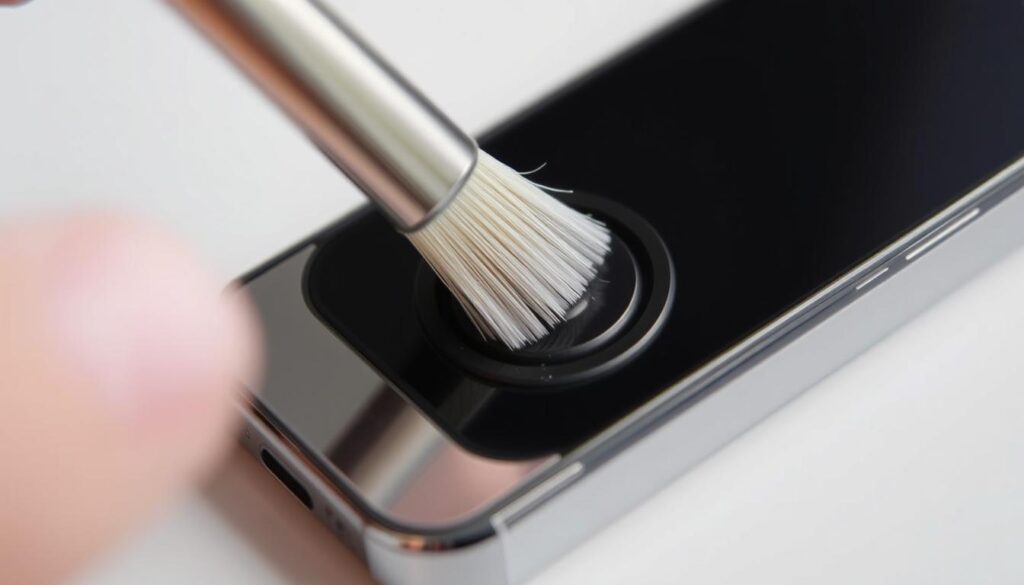
By following these steps and understanding the best practices for dealing with liquid damage, you can increase the chances of saving your iPhone’s speaker and maintaining its overall functionality. For additional iphone speaker cleaning tips, consider exploring other resources that provide comprehensive guidance on maintaining your device.
Using Specialized iPhone Cleaning Products
To keep your iPhone’s speaker in top shape, think about using special cleaning products. These products are made to safely remove dirt and debris that can harm your speaker’s sound.
Commercial Cleaning Solutions
Commercial cleaning solutions are a handy and effective way to clean your iPhone’s speaker. They are made for electronic devices and are safe for sensitive parts.
Electronic-Safe Cleaning Kits
Electronic-safe cleaning kits come with tools and solutions for cleaning electronic devices. They are perfect for those who want a complete cleaning solution.
Specialized Speaker Cleaning Tools
Special tools like small brushes and cleaning solutions are made for cleaning speaker grilles. They help remove debris effectively.
Product Recommendations and Reviews
When picking a commercial cleaning product, read reviews and look for trusted recommendations. Well-known electronics cleaning brands often have good options.
| Product | Rating | Price |
|---|---|---|
| Cleaning Kit A | 4.5/5 | $15 |
| Speaker Cleaning Tool B | 4.8/5 | $10 |
| Electronic Cleaning Solution C | 4.2/5 | $8 |
DIY Cleaning Solutions
If you like to do things yourself, DIY cleaning solutions are a budget-friendly and efficient way to clean your iPhone’s speaker.
Safe Homemade Alternatives
Household items like soft-bristled toothbrushes and dry cloths can clean your iPhone’s speaker. But, avoid harsh chemicals or abrasive materials.
Isopropyl Alcohol Usage (Cautions)
Isopropyl alcohol can clean electronic devices, but use it carefully. Always mix it with water and avoid getting it in the speaker grilles.
Effectiveness Comparison
DIY solutions can work well, but they might not be as thorough as commercial products. Think about the pros and cons before choosing a cleaning method.
Maintenance Tips to Keep Your iPhone Speakers Clean
Keeping your iPhone speakers clean is more than just a one-time task. It’s about being proactive to stop debris from building up and keep your sound quality high.
Preventative Measures
To keep your iPhone’s speaker clean, taking steps before a problem arises is key. This means using protective gear and storing your phone safely.
Protective Cases with Speaker Covers
Using a case with a speaker cover can greatly reduce debris getting into the speaker.
Screen Protectors with Speaker Guards
Some screen protectors have guards for the speaker. These help keep dust and dirt out.
Safe Storage Practices
Keeping your iPhone in a clean, dry spot helps stop dust and moisture from getting into the speaker.
Regular Cleaning Schedule
Having a regular cleaning routine is vital for your iPhone’s speaker.
Weekly Maintenance Routine
Wiping your iPhone with a soft cloth once a week can clear off surface debris.
Monthly Deep Cleaning
Once a month, a deeper clean with a soft brush or compressed air can get rid of tough debris.
Environmental Considerations
Think about where you use your iPhone. Avoid using it in dusty or dirty places.
| Maintenance Task | Frequency | Method |
|---|---|---|
| Quick Wipe | Weekly | Soft Cloth |
| Deep Clean | Monthly | Soft Brush or Compressed Air |
Troubleshooting Common Issues After Cleaning
Cleaning your iPhone speaker is just the first step; troubleshooting is key to resolving persistent issues. If you’re still experiencing problems after cleaning, it’s essential to identify the root cause.
Speaker Still Not Working Properly
If your iPhone speaker is not functioning correctly after cleaning, there are several steps you can take. First, you need to determine whether the issue is software or hardware-related.
Audio Test Procedures
Start by testing your iPhone’s audio. Play some music or a video to check if the sound is clear and distortion-free. You can also make a call to test the speaker’s functionality during a conversation.
Software vs. Hardware Issues
If the audio test reveals distortion or no sound, consider whether the issue might be software-related. Sometimes, a simple restart can resolve the problem.
Reset Sound Settings
If restarting doesn’t work, try resetting your iPhone’s sound settings. This can often resolve issues related to sound quality.
New Noises or Distortions
Sometimes, cleaning the speaker can result in new noises or distortions. This could be due to remaining debris or damage to the speaker.
Identifying Damage vs. Remaining Debris
Carefully inspect the speaker area for any remaining debris. If you find any, gently clean it again using a soft brush or compressed air.
Secondary Cleaning Attempts
If the issue persists, you may need to attempt a secondary cleaning. Be cautious not to push debris further into the speaker.
Software Diagnostic Tools
Utilize software diagnostic tools to check for any software issues that might be causing the problem. Apple’s built-in diagnostics can be helpful in identifying the root cause.
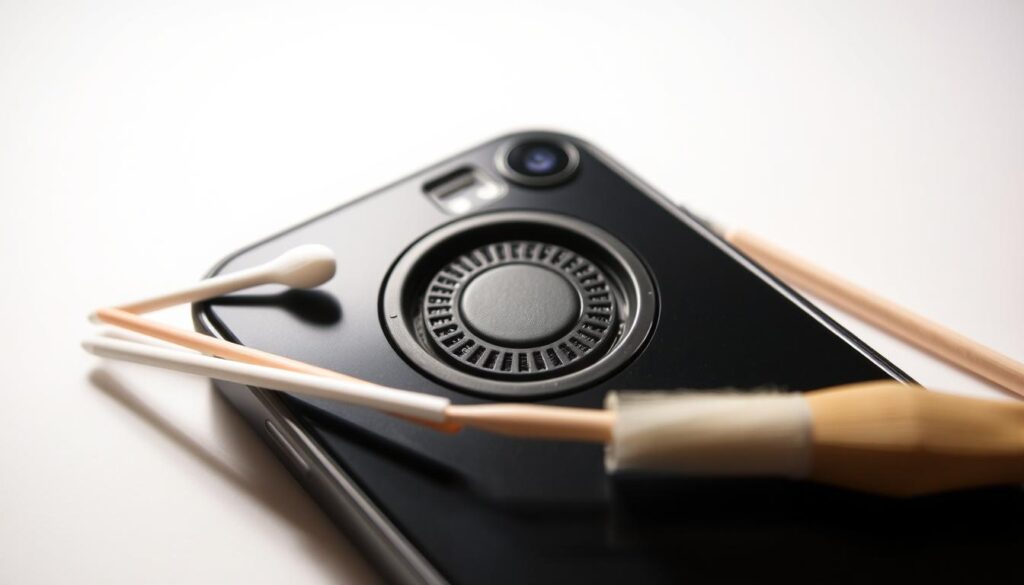
When to Seek Professional Help
When DIY cleaning doesn’t fix speaker issues, it’s time to get professional help. Some problems might not go away, showing you need an expert’s touch.
Signs of Serious Speaker Damage
Spotting serious damage is key before getting help. Watch for these signs:
Persistent Audio Problems
Distorted sound, low volume, or no sound at all after cleaning? It might mean internal damage.
Physical Damage Indicators
Dents, cracks, or corrosion on the speaker grills or around them? It’s a sign of serious damage.
Water Damage Assessment
Been in water? Check for corrosion or mineral deposits inside the speaker. They can cause lasting problems.
Apple Support and Repair Options
Apple has many support and repair choices for damaged iPhone speakers.
| Service | Description | Cost |
|---|---|---|
| Apple Store Genius Bar Services | Expert diagnosis and repair at Apple Stores. | Varies |
| Authorized Service Providers | Reliable third-party repair services approved by Apple. | Varies |
| AppleCare Coverage | Extended warranty that may cover repair costs. | Included with AppleCare+ |
Knowing these options helps you choose the right place for your iPhone’s repair.
Common Mistakes to Avoid When Cleaning iPhone Speakers
When cleaning your iPhone speaker, there are mistakes to avoid. Using the right cleaning methods is key to keep your device’s sound quality and function.
Harmful Cleaning Methods
Some cleaning methods can harm your iPhone’s speakers. It’s important to avoid these harmful techniques.
Using Toothpicks or Pins
Sharp objects like toothpicks or pins can damage the speaker mesh. Avoid using any sharp objects to clean your iPhone speaker.
Applying Liquid Directly to Speakers
Liquids can damage the internal parts of the speakers. Never apply liquid directly to the speakers.
Blowing with Your Mouth
Blowing air from your mouth can push debris further into the speaker. It can also introduce moisture that harms the electronics.
Excessive Force and Pressure
Too much force or pressure can damage your iPhone’s speakers. Be gentle when cleaning to avoid harm.
Damaging the Speaker Mesh
Excessive force can damage the speaker mesh, reducing sound quality. Use gentle cleaning methods to avoid this.
Pushing Debris Further Inside
Using too much force can push debris further into the speaker. Clean with care to avoid pushing debris deeper.
Over-Cleaning Risks
Over-cleaning can wear out the speaker mesh or damage components. Clean your iPhone speaker only when necessary.
By avoiding these common mistakes, you can clean your iPhone speaker effectively. For the best way to clean iPhone speaker, follow gentle and safe cleaning practices.
Cleaning Different iPhone Models
Different iPhone models have unique speaker locations and designs. This means you need to clean them in special ways. Knowing how to clean your iPhone is key to keeping sound quality high.
Older iPhones (iPhone 8 and Earlier)
Older iPhone models, like the iPhone 8 series and earlier, need special care when cleaning speakers.
Home Button Models Cleaning Specifics
Models with a Home button, like the iPhone 8 and earlier, have a unique speaker setup. When cleaning these models, remember to:
- Gently brush around the Home button to remove debris that might affect speaker quality.
- Avoid using liquids or harsh chemicals that could damage the button or surrounding areas.
Headphone Jack Considerations
Older iPhones with a headphone jack need special care when cleaning around this area to prevent damage.
- Use a soft-bristled brush or a dry cotton swab to remove dust and debris from the headphone jack.
Smaller Speaker Grille Techniques
The speaker grilles on older models can be smaller and more delicate. Use a small, soft-bristled brush to clean these areas gently.
Newer iPhones (iPhone X and Later)
Newer iPhone models, starting from iPhone X, have different speaker configurations and additional features like Face ID.
Face ID Models Speaker Locations
For iPhone X and later, the speaker locations have changed slightly due to the absence of the Home button and the introduction of Face ID.
- Be cautious when cleaning around the Face ID area to avoid damaging the TrueDepth camera system.
Stereo Speaker Cleaning
Many newer iPhone models feature stereo speakers, which require careful cleaning to maintain sound quality.
- Use a soft cloth or a small brush to clean both the top and bottom speakers.
Water-Resistant Model Considerations
Some newer models have a level of water resistance. However, this doesn’t make them immune to damage from liquids.
- Avoid using liquids or excessive moisture when cleaning the speakers, even on water-resistant models.
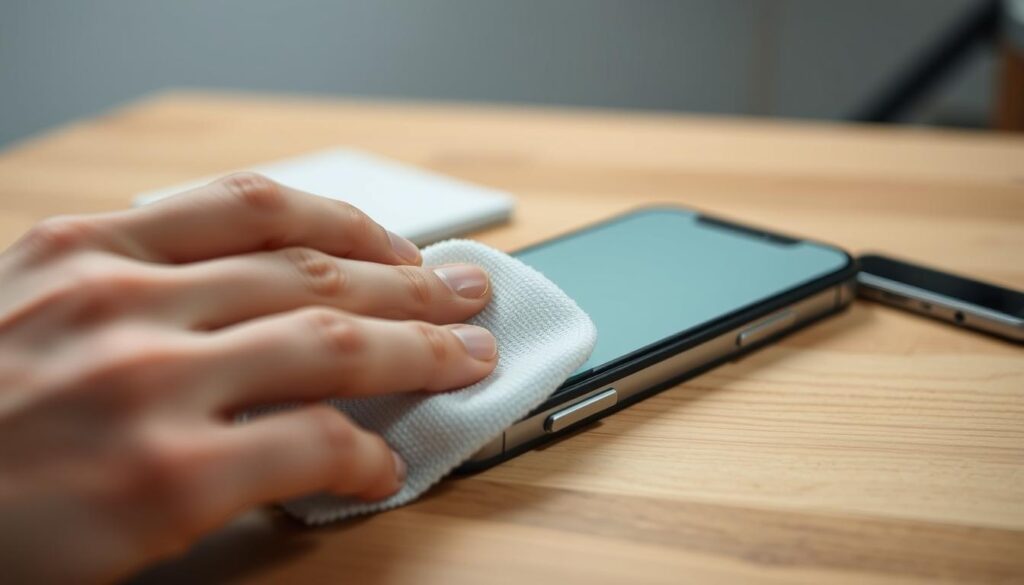
By following these guidelines, you can effectively clean the speakers on your iPhone, regardless of the model. Regular maintenance will help ensure that your device continues to provide high-quality sound.
Conclusion
Cleaning your iPhone’s speaker is easy and keeps sound quality high. Just follow the steps in this guide to keep your speaker working well.
Regular care for your iPhone’s speaker means using the right tools. A soft brush, compressed air, and microfiber cloths are key. They help remove dust and debris that can mess with sound.
Adding iPhone speaker cleaning to your routine helps avoid audio problems. This way, your speaker stays in great shape. You’ll get to enjoy clear, crisp sound.
By taking good care of your iPhone’s speaker, you improve sound quality. Plus, your device will last longer.
FAQ
How often should I clean my iPhone speaker?
Clean your iPhone speaker every few weeks. Do it when you notice sound quality or volume dropping.
Can I use a cotton swab to clean my iPhone speaker?
No, cotton swabs can push debris deeper or leave fibers. Use a soft-bristled brush or microfiber cloth instead.
Is it safe to use compressed air to clean my iPhone speaker?
Yes, but be careful. Don’t spray too close or hard. Hold the can 6 inches away and use short bursts.
What should I do if my iPhone speaker is exposed to liquid?
Turn off your device and remove excess liquid. Let it dry without using heat or inserting objects into the speaker.
Can I use isopropyl alcohol to clean my iPhone speaker?
Isopropyl alcohol is okay for some parts, but not the speaker. Use a damp microfiber cloth instead, but avoid getting liquids in the speaker.
How do I know if my iPhone speaker is damaged beyond repair?
If cleaning doesn’t fix audio problems or you see damage, it might be too far gone. Visit an Apple Store or authorized service provider.
Are there any specialized products for cleaning iPhone speakers?
Yes, there are safe cleaning kits and tools for speakers. Look for reviews to find the right one for you.
Can I clean the earpiece speaker and bottom speaker in the same way?
Cleaning methods are similar, but the earpiece needs extra care. Use a soft-bristled brush or special putty for small areas.
How can I maintain my iPhone speaker’s cleanliness?
Use a protective case and store your iPhone in a clean place. Clean regularly, including weekly and monthly deep cleanings.
What are the signs that my iPhone speaker needs professional cleaning or repair?
If cleaning doesn’t solve problems or you see serious damage, seek professional help. Look for signs like persistent audio issues or physical damage.

